
13 Jul How Minor Water Leaks in Walls Can Cause Mold Growth Over Time
Water leaks in walls may seem like minor issues that can be easily overlooked or dismissed. However, it’s crucial to address even the smallest leaks promptly, as they have the potential to cause significant problems over time. One of the most concerning consequences of untreated water leaks is the growth of mold. In this blog, we will explore how minor water leaks in walls can lead to mold growth and discuss the importance of early detection and remediation. Understanding the risks associated with mold growth can help homeowners take proactive measures to prevent long-term damage and maintain a healthy living environment.
- The Connection between Water Leaks and Mold Growth: Water is the primary ingredient needed for mold to thrive. When even a minor water leak occurs within the walls, it creates a moist environment that provides the ideal conditions for mold spores to germinate and grow. Mold can start developing within 24-48 hours in damp conditions, and over time, it can spread and cause extensive damage to the structure of the wall.
- Hidden Leaks and Concealed Mold: One of the challenges with water leaks in walls is their often-hidden nature. Leaks may originate from plumbing pipes, roof leaks, or even faulty seals around windows and doors. Because these leaks are not immediately visible, they can go unnoticed for an extended period, allowing mold to proliferate behind walls. The presence of mold in concealed areas poses health risks to occupants and requires professional remediation.
- Health Risks Associated with Mold: Mold growth can have detrimental effects on indoor air quality and human health. Exposure to mold spores can cause allergies, respiratory issues, and other health complications, particularly for individuals with pre-existing conditions or weakened immune systems. Infants, children, and the elderly are particularly vulnerable. Therefore, addressing water leaks and preventing mold growth is essential for maintaining a healthy living environment.
- Structural Damage and Costly Repairs: Aside from the health risks, mold growth resulting from water leaks can cause significant structural damage to the walls and surrounding areas. Mold can weaken the integrity of building materials, leading to rot, decay, and even structural failure in severe cases. Repairing such damage can be costly and time-consuming, requiring extensive remediation and reconstruction.
- Early Detection and Prevention: The key to mitigating the risks associated with minor water leaks and mold growth is early detection and prevention. Homeowners should remain vigilant for signs of water damage, such as water stains, musty odors, or peeling paint on walls. Regular inspections of plumbing systems, roofs, and windows can help identify leaks before they escalate into more significant problems.
- Addressing Water Leaks Promptly: Upon detecting a water leak, it is crucial to take immediate action. Start by identifying the source of the leak and addressing the underlying issue. For plumbing leaks, consult a licensed plumber to repair or replace faulty pipes or fixtures. In the case of roof leaks or window seals, engage professional services to seal the openings and prevent further water infiltration.
- Professional Mold Remediation: If mold growth is detected, it is vital to enlist the services of a professional mold remediation company. Attempting to tackle extensive mold growth without the proper knowledge and equipment can exacerbate the problem and pose health risks. Professional remediation experts will assess the extent of the mold growth, contain the affected areas, remove the mold safely, and restore the affected surfaces.
- Preventive Measures for Mold Prevention: In addition to addressing water leaks promptly, homeowners can implement preventive measures to minimize the risk of mold growth. These include maintaining proper indoor ventilation, managing humidity levels, using dehumidifiers in moisture-prone areas, and promptly addressing any signs of water damage. Regular inspections and proactive maintenance can help identify and resolve potential issues before they escalate.
Conclusion
Minor water leaks in walls should not be taken lightly, as they can lead to the growth of mold over time. Mold poses risks to both the structural integrity of the home and the health of its occupants.
By addressing water leaks promptly, conducting regular inspections, and enlisting professional assistance when necessary, homeowners can mitigate the risks associated with mold growth. It is crucial to prioritize early detection and prevention to maintain a safe and healthy living environment. Remember, when it comes to water leaks, even the smallest issue deserves attention and prompt action.
